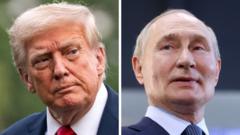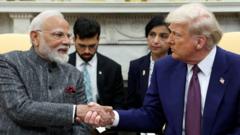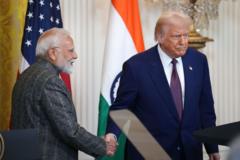As President Trump threatens secondary tariffs against countries that continue to trade with Russia amid the ongoing war in Ukraine, experts warn of potential economic ramifications, including higher energy prices and disrupted trade with nations like India and China.
Trump's Proposed Tariffs on Russian Trade: Implications for the Global Economy

Trump's Proposed Tariffs on Russian Trade: Implications for the Global Economy
New secondary tariffs aimed at nations trading with Russia may have far-reaching effects on energy prices and global trade relations, according to analysis by experts.
The U.S. President Donald Trump's recent announcement of expansive secondary tariffs on countries that trade with Russia could have significant repercussions for the global economy. With the ongoing conflict in Ukraine escalating, Trump aims to exert further pressure on Russia, which has been relying heavily on its energy exports to fund military operations. These tariffs are set to take effect unless a ceasefire is established by August 8.
The proposed secondary tariffs would impose a 100% tax on goods imported into the U.S. from any nation that continues to conduct trade with Russia. Given that Russia is the world's third-largest oil producer, this move targets key buyers like China, India, and Turkey, who have been significant importers of Russian oil and gas. Trump's strategy echoes his earlier tariffs against Venezuelan oil buyers, indicating a willingness to leverage trade as a geopolitical weapon.
As highlighted by experts, this could lead to increased energy prices worldwide. If successful, the tariffs could reduce the flow of Russian oil and gas to international markets, potentially causing prices to rise. However, some analysts suggest that OPEC+ has ample capacity to mitigate price spikes, lessening the tariffs' potential damage.
India, a prominent buyer of Russian oil, is particularly sensitive to these moves. Trump's tariff could double prices on American-made goods like iPhones manufactured in India, ultimately placing the financial burden on consumers. India's government has publicly criticized the U.S. tariffs as "unjustified," pointing to the hypocrisy of continued American trade with Russia.
Turning to China, which consumes the most Russian oil, imposing secondary tariffs is a more complex challenge due to the volume and variety of U.S. imports from China. Trade experts warn that aggressive measures against China could hinder ongoing negotiations and further inflame tensions, potentially leading to economic fallout on both sides.
The European Union also finds itself caught in the crossfire of these new tariffs, as it remains one of the largest markets for Russian energy. Additional sanctions could strain the already delicate trade dynamics with the U.S., affecting essential goods such as pharmaceuticals.
Despite efforts to isolate Russia economically, its economy has shown surprising resilience, escaping recession thus far. However, with increasing financial pressure from sanctions and reduced revenues from oil and gas exports, analysts predict that Russia could soon face significant economic challenges.
In conclusion, while Trump’s new tariff strategy aims to bolster Ukraine and cut off financial support to Russia, the unfurling consequences could lead to increased living costs for consumers globally and more strained diplomatic ties with significant trading partners.




















